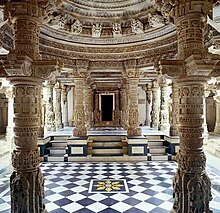Bhamashah
| Bhamashah | |
|---|---|
 | |
| Successor | Jiwashah |
| Born | 24 June 1547 Mewar |
| Died | 1600 (aged 52–53) Mewar |
| Religion | Jainism |
Bhama Shah (1547–1600)[1] was a noted general, minister and close aide of Maharana Pratap Singh. The financial support provided by him allowed Maharana Pratap to restore his army and reclaim much of his lost territory.[2]
Biography
[edit]Bhamashah was born on 24 June 1547 in a Śvetāmbara Jain, Oswal family.[3][4][5] His father Bharmal Kawadia was Gadhpati of Ranthambore Fort appointed by Rana Sangram Singh and was later prime minister under Rana Udai Singh II.[6]

Bhamashah was the Nagar Seth of Chittor. After the costly Battle of Haldighati, Maharana Pratap's financial situation was dire.
Bhamashah and his brother Tarachand[7] gave 2,000,000 gold coins and 25,000,000 silver rupees[7] to Maharana Pratap. They attacked Mughal army camps and partially financed Rana from the gained wealth. Maharana Pratap was able to organize an army and furthered his campaign against the Mughals.
Bhamashah was appointed as the prime minister by Maharana Pratap[7] and Tarachand was appointed as a governor of 'Godwad' region after the Battle of Haldighati.
'Sadri' was founded by Tarachand where he had constructed many buildings. Sadri is considered the gate way to Marwar.[7]
Bhamashah died in 1600. At the time of his death he was Mewar's treasurer under Amar Singh I. Descendants of Bhamashah also served as prime ministers of the Ranas of Udaipur for a few generations. His son Jiwashah was the chief during the rule of Rana Amar Singh, and grandson Akshayraj was the prime minister during the rule of Rana Karan Singh and his descendant Rana Jagat Singh. His descendants still live in Udaipur.
Legacy
[edit]Bhamashah's birth anniversary or Bhamashah Jayanti is celebrated on 29 April every year.[8]
There is a memorial in Udaipur to him. The government of India issued a postage stamp in his honor in the year 2000.[9]
The Maharana Mewar Charitable Foundation has instituted the "Bhama Shah Award" to honour Rajasthani students securing the highest percentage in select departments in the universities of Rajasthan, in recognition of selfless sacrifice, astute financial management, and devotion to duty. The Annual State Award consists of a cash award of ₹2,001 (US$23), a commemorative medal and a Merit certificate.[10]
A Bhamashah Yojana bas been started on his name by government of Rajasthan.[11]
The 1926 silent film Diwan Bhamansha by Mohan Dayaram Bhavnani was based on Bhamashah's life;[12] Another film about the general, titled Bhamashah, was released in 2017.
References
[edit]- ^ Maharana Pratap & his times by Gopi Nath Sharma, M. N. Mathur, Maharana Pratap Smarak Samiti – 1989 – Page 62
- ^ James Tod (1920). Annals and Antiquities of Rajasthan, v. 1 of 3. Oxford University Press. p. 588.
- ^ "Oswals". oswals.net. Retrieved 1 January 2025.
- ^ Singh, Dr. Chhotu Narayan. "Bhamashah Report" (PDF).
- ^ "Bhamashah Award| Annual State Award | Eternal Mewar". www.eternalmewar.in. Archived from the original on 7 August 2024. Retrieved 1 January 2025.
- ^ "वीर शिरोमणि महाराणा प्रताप (भाग -1)". 25 April 2021.
- ^ a b c d Rana, Bhawan Singh (2005). Maharana Pratap By Bhawan Singh Rana. Diamond Pocket Books (P). p. 80. ISBN 9788128808258.
- ^ "I am a proud descendent of Bhamashah: Raj Mahajan". CityAirNews. 27 June 2019.
- ^ "Postage stamp of Bhamashah".
- ^ "Bhamashah Award estd. 1984". Archived from the original on 11 March 2013.
- ^ "भामाशा योजना (Bhamashah Yojana ) | राजस्थान सरकार योजना". पीएम योजना,केंद्रीय और राज्य सरकार योजनाओं, केंद्रीय मंत्रालयों और सरकारी विभागों पर समाचार प्राप्त करें (in Hindi). 8 October 2018. Archived from the original on 6 November 2018. Retrieved 5 November 2018.
- ^ Sanjit Narwekar (1994). Directory of Indian Film-makers and Films. Flicks Books. p. 53. ISBN 978-0-948911-40-8.
Further reading
[edit]- DeshGaurav BhamaShah – Late Shri Harilal Upadhyay, 1976
- The tribes and Cates of the Central Provinces of India, 1916, by Robert Vane Russell, See p. 111-161, history and origins of the Shrimal Oswal Jain Rajput caste.
